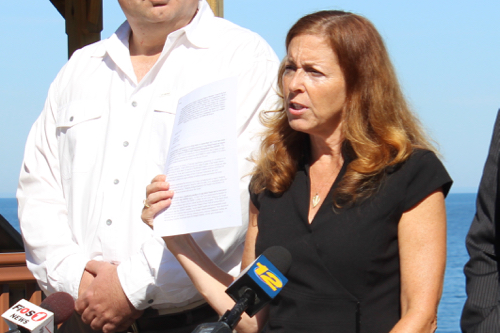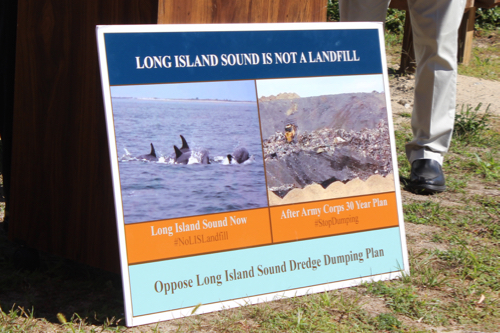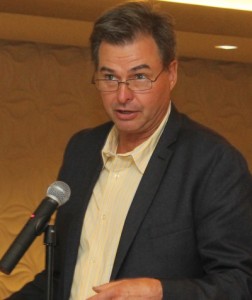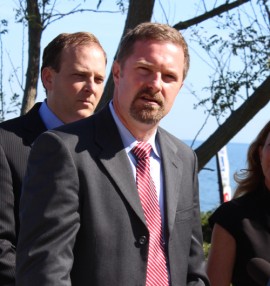Cleaning up the Long Island Sound has been a battle waged through decades of regulation, activism and billions of dollars in spending.
But a new federal plan to continue dumping potentially toxic materials into the Sound would jeopardize the strides Long Island has made to improve its water quality – both for the marine life essential to the island’s economy and for the millions of people living on the Sound’s coastline, according to local environmentalists.
“This is essentially a plan to use Long Island Sound as a landfill,” said Adrienne Esposito, executive director of Citizens Campaign for the Environment. “Long Island Sound is too precious of an economic and environmental resource to be used as a dumping ground.”
The dumping of dredged materials – material that has been dug up from the bottoms of rivers, harbors and inlets, usually to make waterways more navigable – was set to end completely in the Long Island Sound next year. Only four open-water dumping sites are left in the Sound today, leftover from a practice that once allowed dredged materials to be dumped in 22 different sites in the Sound prior to 1980.
A new plan that the U.S. Army Corps of Engineers released last month, however, would continue open-water dumping in the Long Island Sound for the next 30 years. The plan would dispose of between 30 to 50 million cubic yards of dredged waste, mostly dug up from waterways in Connecticut, in at least two local locations in the Sound north of Greenport and Orient.
“We can’t just assume that dumping these waste spoils in the Long Island Sound is environmentally benign,” said Congressman Lee Zeldin, flanked by Esposito and other environmental advocates at a beachside press conference yesterday. “We support dredging initiatives all across the First Congressional District. What we do with those waste spoil is also just as critically important.”

The press conference was called in advance of a public hearing last night, where residents, environmental advocates and elected officials expressed their opposition to the plan at the Hotel Indigo in Riverhead.
Yesterday’s public hearing was the last of only two on Long Island, and it was scheduled only after elected officials blasted the U.S. Army Corps for not giving residents more than one opportunity to attend.
The Army Corps was repeatedly castigated last night for focusing too much on the monetary cost of managing dredged material, rather than considering the cost to residents, marine life and the Long Island economy.
“When you consider the cost, I don’t think you’re considering the value of the natural assets that this plan is going to impact,” said Suffolk County Legislator Al Krupski, who brought with him the unanimous objection of the Suffolk County Legislature to the plan.
Among those are the tens of millions of dollars the Sound contributes every year to the regional economy, providing almost 200,000 jobs to the area. Eight million people live within 50 miles of the Sound’s coastline, Esposito pointed out, and its waters contains more than 120 species of finfish.
“We’ve spent billions cleaning up Long Island Sound,” said Jeremy Samuelson, president of Concerned Citizens of Montauk. “And now for want of a few million dollars extra to do the right thing on the disposal side of the equation, we are going to roll back the gains that we have already made?”
Samuelson went on to call the plan “ludicrous,” “insane” and “counter-productive.”

Many speakers also felt that the Army Corps has not done enough to consider alternatives to open water dumping, such as beach renourishment, wetlands restoration and landfill capping. Esposito pointed out that, unlike Connecticut, New York State has practiced these alternatives for years, and suggested that Connecticut’s support for the plan stems from Connecticut State’s lack of experience with beneficial reuse.
Several brought up the previous version of this plan that was rejected by two governors and the Environmental Protection more than a decade ago.
That plan, introduced in 2004, proposed dumping 20 million cubic yards into the Sound over the course of 20 years. It was rejected in favor of a mandate that required the Army Corps to phase out open water disposal and implement beneficial reuse of the waste.
But the plan the Army Corps proposed late last month calls for the dumping of 30 to 50 million cubic yards into the Sound over the course of 30 years instead.
“This plan is on the same bad premise that got it rejected in the first place,” Esposito said. “It’s just a bigger, badder plan.”
“Far from representing a reduction or elimination of the offending elements of the prior plan,” said Samuelson, “this is doubling down and extending the calendar on a failed plan.”
Environmental advocates presented the Army Corps last night with a letter of objection signed by 25 different stakeholder organizations from across Long Island. Several elected officials also spoke at the meeting, including State Assemblyman Steve Englebright and Southold Councilman Mark Terry. No one representing Riverhead Town attended the hearing.
Representatives from the Army Corps thanked residents for attending and sharing their opinions. “We appreciate all your comments here tonight,” said Todd Randall, project ecologist. “We’ll take them all into consideration.”
The Army Corps has received more than 250 written comments so far in response to the plan. Though yesterday was the final public hearing, written comment will remain open until October 16.
Denise Civiletti contributed reporting.
The survival of local journalism depends on your support.
We are a small family-owned operation. You rely on us to stay informed, and we depend on you to make our work possible. Just a few dollars can help us continue to bring this important service to our community.
Support RiverheadLOCAL today.
































